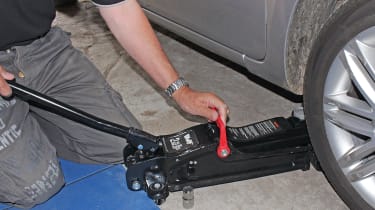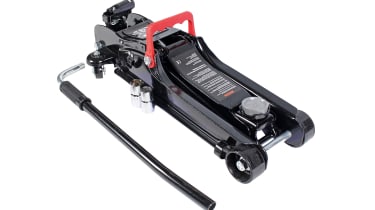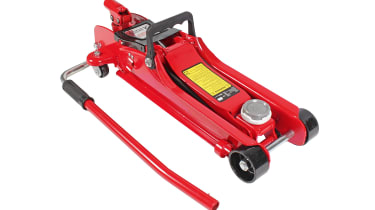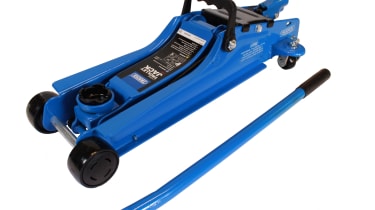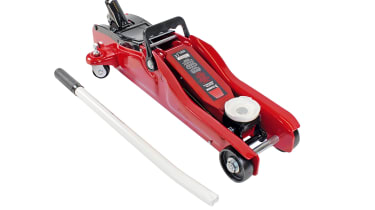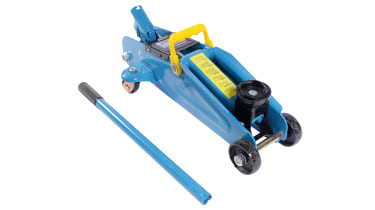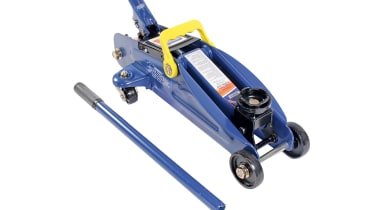What’s the best heavy lifter for DIY work? We test eight of the best to find out…
Lots of DIY tasks need a car to be raised off the ground, but jacks supplied in the boots of most cars are lightweight and designed just for emergencies. A trolley jack is a better, safer option and, for most models, not expensive. It may be tempting to use the jack supplied to change the tyres, but you should resist; these are for emergency use only when faced with a puncture away from home. Their lightweight build and clumsy operation make them ill-suited for garage work.
A trolley jack is a much better option, and even the most expensive option among those we’ve tested here won’t break the bank. Unless you have a particularly hefty vehicle, the eight jacks we rate should be more than equal to the task.
How we tested them
We compared the various specs, not least the starting height – vital for owners of sports cars and those with lowered suspension. The maximum height is also a factor where taller SUVs and crossovers are concerned. We counted the number of pumps needed to reach 200mm – a common height for car jacking points.
We expected good instructions with each of our jacks and, ideally, on the jack arm. The saddle size was logged, plus a strong case is always useful to keep it clean and make it simple to carry in the car. Finally, we factored in the price.
Verdict
A better price and warranty help the Wolf Black Jack snatch the win from the identical Clarke Strong Arm, with the Draper keeping them both honest.
- Wolf Black Jack 2.25T Low Profile Trolley Jack
- Clarke Strong Arm 2.25 Tonne Low Entry Trolley Jack with Sockets CTJ2250LP
- Draper 2 Tonne Low Entry Trolley Jack 02082
Reviews
Wolf Black Jack 2.25T Low Profile Trolley Jack
Price: Around £42Rating: 5/5
Our current champion keeps its crown for this test, with a 2.25-tonne rating making it capable of easily tackling most cars. With a starting point at a mere 80mm (just over three inches), it would work on all but the lowest cars, and its max height of 380mm worked well with our family hatchback.
At 97mm, it was wide enough to be stable as we manoeuvred it into position to remove a wheel. We liked the tough plastic case that housed two double-ended sockets of 17mm, 19mm, 21mm and 23mm, which should cover most popular cars’ wheel nuts or bolts, and is a handy touch. Another neat addition was the rubber saddle pad, useful for protecting the underside of the car. A keen price and impressive 24-month warranty complete a great package.
Clarke Strong Arm 2.25 Tonne Low Entry Trolley Jack with Sockets CTJ2250LP
Price: Around £50Rating: 4.5/5
The Clarke Strong Arm's low entry point and joint highest max reach give an impressive 300mm span. The 360-degree turning handle socket is useful for tricky situations, and we liked the two double sockets and long, 480mm handle. Instructions were comprehensive and the removable saddle pad was ideal for avoiding paint damage when lifting. But its price and single-year warranty demote it.
Draper 2 Tonne Low Entry Trolley Jack 02082
Price: Around £50Rating: 4.5/5
The basic design of the Draper mimics other popular trolley jacks such as our champion Wolf, although curiously, it’s rated slightly lower, at two tonnes. Visually extremely similar, it too has wheels large enough to be stable, yet get easily under the car, and comes with a one-piece handle and safety valve to prevent overloading.
It lost a little ground due to its slightly smaller saddle (47mm against 55mm), and its lack of protective rubber pad or wheel nut sockets. The instructions on the jack arm are good, and the supplied booklet covers all the important safety issues.
In use, it fell behind on only a few small factors, although the one-year warranty and higher price lost it more points. In our last test it would have been a Recommended buy, finishing slightly behind the Clarke.
Sealey 1050CXLE 2 tonne Low Entry Short Chassis Trolley Jack
Price: Around £40Rating: 4/5
The new Sealey has a lower starting point than our top two, albeit by 2mm, but tops out 30mm lower, at 330mm. Instructions were sparse, yet it was the only one with spare seals – handy as the jack ages. Its 60mm saddle is the biggest here, and the 505mm handle took some of the effort from pumping. With 17 strokes to 200mm, it matched the Wolf and Clarke, and while it’s shorter than them and trails on span, we liked it.
RAC 2 Tonne Trolley Jack HP218A
Price: Around £35Rating: 3/5
The RAC offering is the best of the smaller jacks, thanks to a slightly more competitive price. A blow-moulded plastic case made it easy to transport, although the central plastic carry handle had to be removed to close it. The lowest position of 130mm was conventional, but it won points for its max of 340mm, 10mm up on the Silverline, Draper and Sakura. Photos and instructions were good, plus it took an average 15 strokes to 200mm.
Silverline 2 Tonne Hydraulic Trolley Jack 633935
Price: Around £35Rating: 2.5/5
As with rivals, the Silverline started at 130mm, with a span of 200mm – limiting taller vehicles. The 420mm handle is the joint shortest, yet it took only 14 strokes to reach 200mm. The instructions were complete but short, and those on the jack arm were very limited. We liked the 55mm saddle and the strong case, which was worth the extra, giving it an edge over the ‘naked’ Sakura.
Sakura 2 Tonne Hydraulic Floor Jack SS5191
Price: Around £25Rating: 2.5/5
The Sakura still trails the RAC and Silverline, but not the pricier Draper. Its 420mm handle is the joint shortest, so pumping could be harder work than some, yet 14 strokes to 200mm was good. Its start height of 130mm and 420mm length may hold it back. The instructions covered key points, but we’d have liked more on the jack arm. Still a contender, yet with no case, it trails the Silverline.
Draper 2 Tonne Light Duty Trolley Jack 27634
Price: Around £35Rating: 2/5
At around 8.5kg, the Draper is light enough to carry easily. We rated the instructions, with their handy photos and exploded diagrams. Its specs are all but identical to the others in this class, although it edged ahead with just 12 strokes to 200mm and a slightly longer 425mm handle. Yet it lost out with the smallest saddle on test and by having no case. And the price is too high.
Source: Read Full Article

